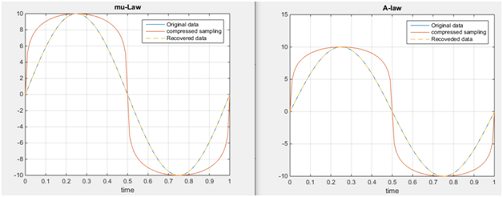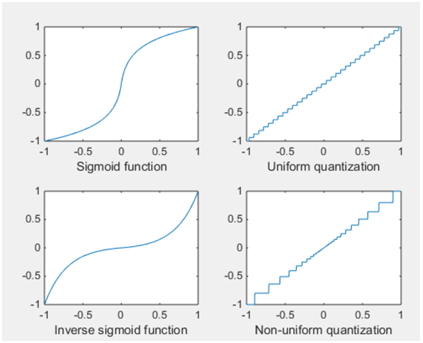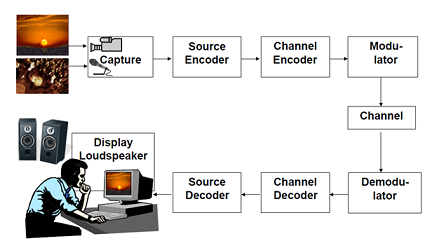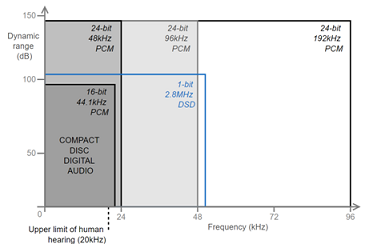Source Coding Implementation Using MATLAB/Simulink Assignment -
Learning Outcomes
a. Apply and evaluate the principles used in the generation, transmission and reception of digitally modulated signals;
b. Report on the characteristics of sampling and analogue to digital conversion and source coding;
c. Distinguish the digital modulation and demodulation techniques, channel coding and decoding and their performance;
d. Apply the techniques of, and report on, digital communication applications using matlab and hardware devices.
Assignment Description: The purpose of this assignment is to motivate students to seek application of waveform coding techniques for digital audio transmission and digital audio recording.
GET ASSURED A++ GRADE IN EACH SOURCE CODING IMPLEMENTATION USING MATLAB ASSIGNMENT ORDER - ORDER FOR ORIGINALLY WRITTEN SOLUTIONS!
PART A: Implementation of µ-law and A-law Compandor
Most modern communications systems operate in the digital domain for various reasons. However, most practical signals handled by these systems are naturally analogue in nature. Thus, an interface is needed between the signals and the systems handling them. This interface is called analogue-to-digital converter (ADC) and it's reciprocal, digital-to analogue converter (DAC). The three main functions of the ADC are sampling, quantization and encoding.
Requirements -
1) Implement nonlinear quantizers µ-law and A-law compandor in MATLAB/Simulink and compare the results. Matlab/Simulink code is required to be included in the report.
2) Prepare a report incorporating theories behind non-uniform quantization. Report should include comparison result and its interpretation from the simulation.
Solution -
MATLAB code:
clc;
close all;
clear;
%% Program starts here
t=0:0.01:1; % time duration
f=1; % frequency of the input signal
Input_data = 10*sin(2*pi()*f*t); % input signal
%% companding the input signal
compressed_mu_law = compand(Input_data,255,max(Input_data),'mu/compressor');
%% recovery of input signal
expanded_mu_law = compand(compressed_mu_law,255,max(Input_data),'mu/expander');
%% plot the quantized and recovered data using mu Law.
figure;
plot(t,Input_data,t,compressed_mu_law,t,expanded_mu_law,'--');
title('mu-Law');
grid on;
xlabel('time');
legend('Original data','compressed sampling','Recovered data')
%% A-Law
data_a_law = 10*sin(2*pi()*f*t); % Input data
%% companding the input signal using A-Law
compressed_a_law = compand(data_a_law,90,max(data_a_law),'a/compressor');
%% recovery of qunatized signal using A-law
expanded_a_law = compand(compressed_a_law,90,max(data_a_law),'a/expander');
%% plot the quantized and recovered data using A Law.
figure;
plot(t,data_a_law,t,compressed_a_law,t,expanded_a_law,'--');
title('A-law');
grid on;
xlabel('time');
legend('Original data','compressed sampling','Recoveded data');
immse_mu_law=immse( Input_data , expanded_mu_law );
immse_a_law=immse(data_a_law, expanded_a_law);
disp('Mean Squared Error for Mu-law');
immse_mu_law
disp('Mean Squared Error for A-law');
immse_a_law
%% program ends here
Results:


Mean Squared Error for Mu-law
immse_mu_law = 1.5111e-29
Mean Squared Error for A-law
immse_a_law = 4.9580e-30
NO PLAGIARISM POLICY - ORDER NEW SOURCE CODING IMPLEMENTATION USING MATLAB ASSIGNMENT & GET WELL WRITTEN SOLUTIONS DOCUMENTS WITH FREE TURNTIN REPORT!
Discussion:
Suppose an input signal x is to be transmitted and therefore after passing through µ-law compressor is given by the below expression
y = ((V log(1+ μ|x|/V)/(log(1+μ)))sgn(x)
Suppose an input signal x is to be transmitted and therefore after passing through A-law compressor is given by the below expression

From the above results, we can see that mean squared error in case of A-Law is lesser than µ-Law.
Mean Squared Error for µ-Law = 1.5111e-29
Mean Squared Error for A-Law = 4.9580e-30
ENDLESS SUPPORT IN SOURCE CODING IMPLEMENTATION USING MATLAB ASSIGNMENTS WRITING SERVICES - YOU GET REVISED OR MODIFIED WORK TILL YOU ARE SATISFIED WITH OUR SOURCE CODING IMPLEMENTATION USING MATLAB ASSIGNMENT HELP SERVICES!
PART B: Source Coding in Digital Audio Systems
Digital audio has become an integral part of our lives. Nearly all of the transmission of speech signals over telephone channels is currently digital. Moreover, digital audio recording in the form of compact disks (CDs) has become very popular. This assignment exposes the student to real world applications of digital communication in digital audio transmission and recoding. Therefore, the student shall acquire skills to understand the real world requirements, critically review the existing techniques and write a technical report based on his or her investigation.
Requirements -
1) a) Requirement analysis: analyze the following for digital audio in telephone transmission systems:
- Bandwidth of speech signals and the required sampling rates to avoid aliasing
- Required number of bits per sample to achieve voice quality in telephony
b) In addition, analyze the following for digital audio recording:
- Bandwidth of high quality audio and the required sampling rates
- Required number of bits per sample to achieve a high signal to quantization noise level for high quality audio.
2) Investigation of current methods: student is required to review and analyze waveform-coding techniques used in digital audio transmission and recording at present. At least PCM and DPCM methods need to be covered.
Solution -

A typical flow diagram for the audio transmission is given above. Typical human voices range from 300Hz to 3100Hz. speech signal has a bandwidth of 2800 Hz. In order, to transmit the audio signals faithfully we provide sufficient guard band before transmission. Therefore, for the faithful transmission of the human audio signal typically we use 8KHz of bandwidth. Each sample is then encoded in 8bits per sample. Therefor the rate of digital audio transmission is 64 kbps. The bandwidth increases as the desired quality increases. Below diagram represents the typically used audio signal in industry and their bandwidth requirement.

HELPING STUDENTS TO WRITE QUALITY SOURCE CODING IMPLEMENTATION USING MATLAB ASSIGNMENT AT LOW COST!
Digital audio transmission has advanced a lot in recent times. With the advent of computer technology, processing of analog audio signal has become easier. The analog signal is first converted to digital signal and the digital signals are processed accordingly. There are many encoding methods that are used for audio processing. Below are the list of encoding techniques that are used frequently in digital audio transmission.
1. PCM
2. LPCM
3. DPCM
4. ADPCM
5. Delta Modulation
We will discuss above methods in details.
1. Pulse-code modulation (PCM): Analog signal is sampled at equal interval of time and the amplitude of the signal is stored. The amplitude of the sample is then rounded to the nearest Quantization level. The digital equivalent of the Quantized level id the PCM representation of the sampled analog signal.
2. Linear pulse-code modulation (LPCM): This method of modulation is a variant of PCM described above. The difference in LPCM is that quantization level is linearly uniform.
3. DPCM: one of the major drawbacks of above PCM and LPCM is that as the amplitude of the input signal increases, we will need more number of bits for the representation of data in order to get equal quantization error. In this encoding scheme, instead of encoding the actual sample amplitude, we encode differences between the current and the predicted value.
4. Adaptive DPCM: As the name suggest, it is adaptive in nature and therefore quantization steps are non-uniform. The quantization steps are more when amplitude is less and vice versa.
5. Delta modulation: This special type of DPCM, where only 1 bit is used for each sample. The difference between present and last sampled values will be just a single bit.
GET READYMADE SOURCE CODING IMPLEMENTATION USING MATLAB ASSIGNMENT SOLUTIONS - 100% PLAGIARISM FREE WORK DOCUMENT AT NOMINAL CHARGES!